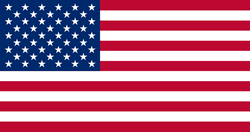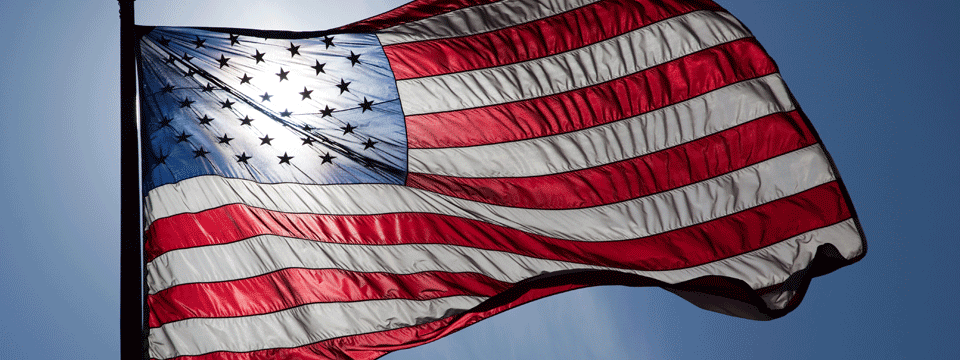US Flag Code
The information below is a summary of Chapter 1 of Title 4 of the United States Code (commonly referred to as the US Flag Code), as posted on Wikipedia.
The flag should never be dipped to any person or thing, unless it is the ensign responding to a salute from a ship of a foreign nation.
When a flag is so tattered that it no longer fits to serve as a symbol of the United States, it should be replaced in a dignified manner. The Veterans of Foreign Wars, American Legion, Boy Scouts of America, Girl Scouts of the USA, TrailLife USA, the military and other organizations regularly conduct dignified flag-burning ceremonies. We collect old flags at our post – drop by any time and place it in the receptacle outside.
No part of the flag should ever be used as a costume or athletic uniform. However, a flag patch may be affixed to the uniform of military personnel, firemen, policemen, and members of patriotic organizations.
The flag should never touch anything beneath it.
The flag should always be permitted to fall freely. (An exception was made during the Apollo moon landings when the flag hung from a vertical pole designed with an extensible horizontal bar, allowing full display even in the absence of an atmosphere.)
The flag should never be used for advertising purposes in any manner whatsoever. It should not be embroidered on such articles as cushions or handkerchiefs and the like, printed or otherwise impressed on paper napkins or boxes or anything that is designed for temporary use and discard.
The flag should never be upside down. According to the United States Flag Code, an American flag upside down means a sign of distress or great danger.
Rules for Display of the American Flag
The information below comes from USFlag.com’s Flag Etiquette page.
Display Outdoors
Over the Middle of the Street
It should be suspended vertically with the union to the north in an east and west street or to the east in a north and south street.
Flown at Half-staff
Should be first hoisted to the peak for an instant and then lowered to the half-staff position. The flag should be again raised to the peak before it is lowered for the day. By “half-staff” is meant lowering the flag to one-half the distance between the top and bottom of the staff. Crepe streamers may be affixed to spear heads or flagstaffs in a parade only by order of the President of the United States.
Flown on the Same Halyard with Non-Nation Flags
The American Flag should always be at the peak. When the flags are flown from adjacent staffs, the flag of the United States should be hoisted first and lowered last. No such flag or pennant may be placed above the flag of the United States or to the right of the flag of the United States.
Suspended Over a Sidewalk
The flag may be suspended from a rope extending from a house to a pole at the edge of the sidewalk, the flag should be hoisted out, union first, from the building.
From a Staff Projecting Horizontally or at an Angle
The flag may be projected from the window sill, balcony, or front of a building, with the union of the flag placed at the peak of the staff unless the flag is at half-staff.
In a Parade with Other Flags
The flag, when carried in a procession with another flag, or flags, should be either on the marching right; that is, the flag’s own right, or, if there is a line of other flags, in front of the center of that line.
With Non-National Flags
The flag of the United States of America should be at the center and at the highest point of the group when a number of flags of States or localities or pennants of societies are grouped and displayed from staffs.
With Other National Flags
When flags of two or more nations are displayed, they are to be flown from separate staffs of the same height. The flags should be of approximately equal size. International usage forbids the display of the flag of one nation above that of another nation in time of peace.
With Another Flag Against a Wall from Crossed Staffs
Should be on the right, the flag’s own right which is the viewer’s left, and its staff should be in front of the staff of the other flag.
Display Indoors
From a Staff in a Church or Public Auditorium on a Podium
The flag of the United States of America should hold the position of superior prominence, in advance of the audience, and in the position of honor at the clergyman’s or speaker’s right as he faces the audience. Any other flag so displayed should be placed on the left of the clergyman or speaker (to the right of the audience).
From a Staff in a Church or Public Auditorium off the Podium
Custom and not the flag code hold that the flag of the United States of America should hold the position of superior prominence as part of the audience, in the position of honor at the audience’s right.
Used to Cover a Casket
It should be so placed that the union is at the head and over the left shoulder. The flag should not be lowered into the grave or allowed to touch the ground.
Other than being Flown from a Staff
The flag should be displayed flat, whether indoors or out. When displayed either horizontally or vertically against a wall, the union should be uppermost and to the flag’s own right, that is, to the observer’s left. When displayed in a window it should be displayed in the same way, that is with the union or blue field to the left of the observer in the street. When festoons, rosettes or drapings are desired, bunting of blue, white and red should be used, but never the flag.
Flag Folding

The flag folding ceremony described by the Uniformed Services is a dramatic and uplifting way to honor the flag on special days, like Memorial Day or Veterans Day, and is sometimes used at retirement ceremonies.
Here is a typical sequence of the reading:
(Begin the reading as the Honor Guard or Flag Detail begins coming forward)
The flag folding ceremony represents the same religious principles on which our country was originally founded.
The portion of the flag denoting honor is the canton of blue containing the stars representing the states our veterans served in uniform.
The canton field of blue dresses from left to right and is inverted when draped as a pall on a casket of a veteran who has served our country in uniform.
In the Armed Forces of the United States, at the ceremony of retreat the flag is lowered, folded in a triangle fold and kept under watch throughout the night as a tribute to our nation’s honored dead.
The next morning it is brought out and, at the ceremony of reveille, run aloft as a symbol of our belief in the resurrection of the body.
(Wait for the Honor Guard or Flag Detail to unravel and fold the flag into a quarter fold-resume reading when Honor Guard is standing ready)
The first fold of our flag is a symbol of life.
The second fold is a symbol of our belief in the eternal life.
The third fold is made in honor and remembrance of the veteran departing our ranks who gave a portion of life for the defense of our country to attain a peace throughout the world.
The fourth fold represents our weaker nature, for as American citizens trusting in God, it is to Him we turn in times of peace as well as in times of war for His divine guidance.
The fifth fold is a tribute to our country, for in the words of Stephen Decatur, “Our country, in dealing with other countries, may she always be right; but it is still our country, right or wrong.”
The sixth fold is for where our hearts lie. It is with our heart that we pledge allegiance to the flag of the United States of America, and to the republic for which it stands, one nation, under God, indivisible, with liberty and justice for all.
The seventh fold is a tribute to our Armed Forces, for it is through the Armed Forces that we protect our country and our flag against all her enemies, whether they be found within or without the boundaries of our republic.
The eighth fold is a tribute to the one who entered in to the valley of the shadow of death, that we might see the light of day, and to honor mother, for whom it flies on mother’s day.
The ninth fold is a tribute to womanhood; for it has been through their faith, love, loyalty and devotion that the character of the men and women who have made this country great have been molded.
The tenth fold is a tribute to father, for he, too, has given his sons and daughters for the defense of our country since they were first born.
The eleventh fold, in the eyes of a Hebrew citizen, represents the lower portion of the seal of King David and King Solomon, and glorifies, in their eyes, the God of Abraham, Isaac, and Jacob.
The twelfth fold, in the eyes of a Christian citizen, represents an emblem of eternity and glorifies, in their eyes, God the Father, the Son, and Holy Ghost.
When the flag is completely folded, the stars are uppermost, reminding us of our national motto, “In God we Trust.”
(Wait for the Honor Guard or Flag Detail to inspect the flag — after the inspection, resume reading)
After the flag is completely folded and tucked in, it takes on the appearance of a cocked hat, ever reminding us of the soldiers who served under General George Washington and the sailors and marines who served under Captain John Paul Jones who were followed by their comrades and shipmates in the Armed Forces of the United States, preserving for us the rights, privileges, and freedoms we enjoy today.
For more information, please visit the national VFW Flag Etiquette page, or ask one of our members. We’d be glad to help educate our fellow American Citizens.

